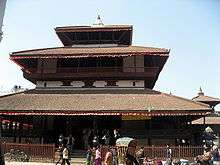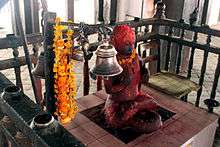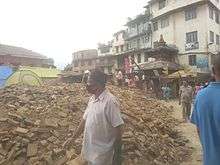Kasthamandap

Coordinates: 27°42′14″N 85°18′21″E / 27.70400°N 85.30583°E

Kasthamandap (Sanskrit: काष्ठमन्डप, Nepal Bhasa:मरु सत: Maru Satta:; literally "Wood-Covered Shelter") was a three-storied public shelter that included a shrine consecrated to Gorakshanath situated at Maru, Kathmandu, Nepal.[1][2] Several myths and stories about the date of the construction of the Kasthamandap Temple have been resolved with the recent archeological findings. The newly discovered objects during the excavation here in the aftermath of the 2015 earthquake have suggested that the Kasthamandap may have been built in the 7th century during the Lichhavi era.[3]
Before this, it was assumed that the Kasthamandap was built in around the 12th century.
A team of international and national experts from the Department of Archaeology (DoA), Government of Nepal and Durham University had excavated beneath the Kasthamandap and found coal and sand in the foundations. The foundation soil, coal, and sand were taken to the University of Stirling, Scotland for carbon and optically stimulated luminescence (OSL) tests. Nearly seven months of lab tests showed that the Kasthamandap Temple was built in the 7th century, said Ram Kunwar, spokesperson at the Department of Archeology (DoA).[4]
Senior archaeologist Kosh Prasad Acharya, who was involved in the team led by experts from Durham University, said that the result of the lab test of the coal found during the excavation proved that it was 2,200 years old, and it was a farming land before the construction of the Kasthamandap.
The team is now carrying out excavation works of the Kasthamandap with the financial and technological support of the National Geographic Society and Art and Humanities Research Council.
It is said that the Kasthamandap was built from the timber of a single tree. Scientific tests of the sample wood are also being conducted to see if this is the case.
It was revealed that there was no fault with the construction of the Kasthamandap’s foundation, but a fault was found in the construction process above it.
Among the four pillars, one was negligently erected, which led to the destruction of Kasthamandap in the earthquake, said the experts.
The foundation of the heritage site was found strongly built using traditional methods. During the cleaning of the debris, more damage was done by the use of dozers, they said.
2015 Nepal earthquake and subsequent excavations

On 25 April 2015, Kasthamandap temple along with many others on the Kathmandu Durbar Square, was damaged and collapsed by the April 2015 Nepal earthquake, which had an estimated magnitude of 7.9 (Mw).[5][6]
During the excavations, copperplate inscriptions mentioning of Jayasthithi Malla, Jyotir Malla and Yogmati Bhattarika have been recovered from a pillar of the Kasthamandap Temple.[7] In the manuscripts dated Nepal Sambat 499, 454 and 543, (AD 1288, 1243, 1332) it is written that the person responsible for operating the Pachali Bhairav Jatra has to organise the festival following the specific regulations.[8]
References
- ↑ Kasthamandap: Microcosm of Kathmandu’s Living Culture and Storied History, by Dipesh Risal, Asian Art, September 03, 2015
- ↑ Ramesh Jung Thapa. Kasthamandap
- ↑ Archaeological findings prove the Kasthamandap was built in the 7th century, Rising Nepal, Binu Shrestha, Nov. 18, 2016
- ↑ Excavation works continue at the Kasthamandap, Rising Nepal, Kathmandu, Dec 1
- ↑ "Rajesh Gurung's photos for The Himalayan Times". Retrieved April 25, 2015.
- ↑ "Nepal earthquake collapses buildings in Kathmandu and northern India killing more than 1,300, officials say". Retrieved April 25, 2015.
- ↑ A Report on the Salvaging, Screeening and Inventorying of Carved Wooden Elements of HANUMAN DHOKA PALACE COMPLEX (Organized by the Department of Archaeology with support from the UNESCO Kathmandu and in collaboration with ICOMOS Nepal), p. 35
- ↑ Malla-era manuscripts found, Rising Nepal, Oct. 27, 2016